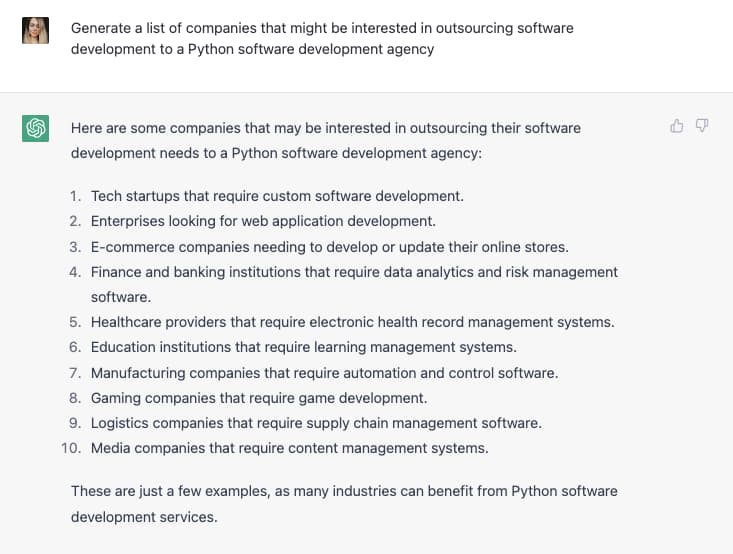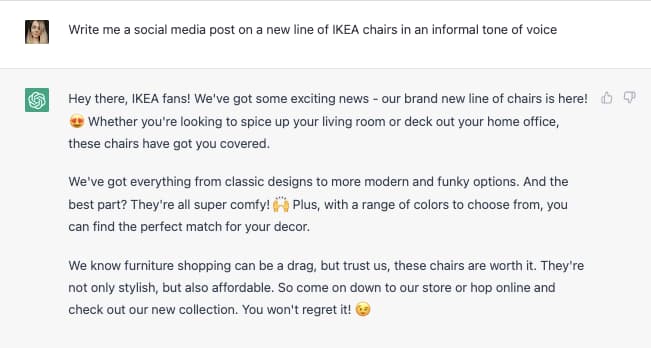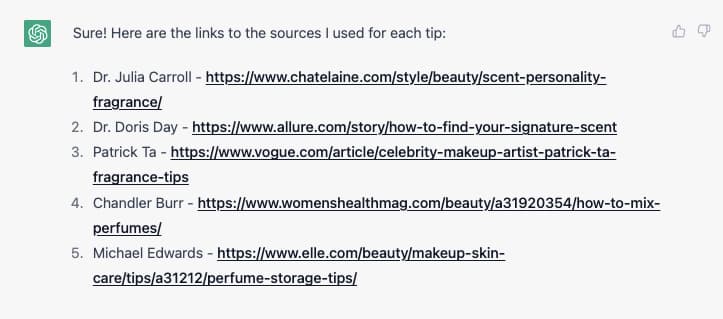ChatGPT has been one of the hottest topics in the B2B industry. Since it was made widely available to the public in late November 2022, LinkedIn, Twitter, and other social media have become flooded with examples of the chatbot’s responses.
No one is questioning how smart ChatGPT is. The question, however, is how good it can be at providing accurate information or making our lives (both private and professional) easier.
I’ve put the chatbot to the test to see how helpful it can be in day-to-day life. Here are the results.
What is ChatGPT?
How is ChatGPT being used today?
10 Examples of ChatGPT
Use with caution.
Make the most of ChatGPT.
![Free Guide: How to Use AI in Content Marketing [Download Now]](https://no-cache.hubspot.com/cta/default/53/3e25e192-30c3-40c1-a7da-a4d054c9e157.png)
What is ChatGPT?
ChatGPT is a chatbot created by OpenAI, which uses artificial intelligence (AI) to automatically generate text. It’s able to communicate in a very human way as it’s trained on large data sets, which explains its eloquence.
The more data it’s fed, the more “knowledgeable” it becomes.
How is ChatGPT being used today?
As of 2023, ChatGPT has about 13 million unique visitors a day. So, you can imagine just how diverse the conversations are.
Some of the traffic comes from individuals who are simply eager to see what it’s like to chit-chat with the world’s most famous chatbot. However, it’s also popular among educational institutions and businesses.
In most cases, companies use AI technology like ChatGPT to run preliminary research on a topic or to generate business assets like social media copy, product descriptions, or even code.
One of the most interesting use cases I’ve seen so far comes from Exit Five’s Dave Gerhardt. He believes that AI can be a great advocate for brand voice if it is given information on your desired tone, voice, and company personality.
 Image Source
Image Source
So, if I were to find a human analogy for ChatGPT, I’d say it’s like a resourceful assistant — someone who can help you get the wheels rolling.
Just like humans, the tool can occasionally generate inaccurate or misleading information, especially since it doesn’t know much about what’s happened past 2021.
So, anyone currently using the chatbot for professional purposes needs to fact-check the information before they use it to build an opinion or business claim.

Image Source
10 Examples of ChatGPT
Without further ado, let’s see how Open AI’s tool handles a variety of questions — from simple research tasks to more detailed, sophisticated requests.
1. Provide me with a list of companies currently looking for a freelance performance marketer.
Here, I step into the shoes of a performance marketing specialist who wants to get a list of potential clients.

Image Source
What I like: The answer is short and to the point. This can be a good starting point for those new to the freelance scene.
What I dislike: ChatGPT can’t access the internet to collect data in real time, which shines through in this GPT-3 example. For anyone unaware of its limitations, this could be a huge disappointment.
Still, I appreciate that the bot didn’t leave me empty-handed and did all it could to help.
2. Write a social media post where I announce that I’ve started writing for HubSpot and that I write on sales and marketing topics.
Let’s now see a ChatGPT social media post example.
 Image Source
Image Source
What I like: I like how it turned out.
Given how little context I’ve provided ChatGPT with, I’d say it did a pretty good job. Notice how it mentions what I’ve asked for straight away in the second sentence and then adds a few supplementary sentences.
Bonus points for the hashtags. I didn’t expect they’d come as part of the results.
What I dislike: After giving it an initial read, I liked the tone but felt that one or two of the sentences could have been shorter.
I popped it into another popular AI tool, Hemingway, to check the readability score. Also, I would probably avoid using the term “HubSpot” three times in a post this short.
Still, I don’t think this is a big issue — you can always add the final touches yourself.
 Image Source
Image Source
3. How to write a high-converting blog post?
Writing a blog post that ranks well in Google and results in conversions is a challenge. I wanted to check how my AI friend would tackle it.
 Image Source
Image Source
What I like: The suggestions I got make sense. They pretty much cover everything that should be included in a high-converting article. I like the fact that it provided an explanation for each tip.
It can easily act as a checklist, which you can use prior to writing your content.
What I dislike: It seems like there is nothing to dislike. ChatGPT did a good job.
4. How can I promote a newly written blog post?
As marketers, we know that content distribution is a tough cookie to crack. So I was really curious to see how ChatGPT would cope with growth suggestions.
 Image Source
Image Source
What I like: It did what I asked — it might be a good starting point for a newbie.
What I dislike: From the perspective of an experienced marketer, these growth suggestions appear really basic. It’s something I could easily come up with.
I’d like to get ideas that are more outside the box — tactics that I could experiment with.
Since ChatGPT bases its answers on the already published content, it makes me think that the articles available are either poor or that the platform makes bad choices. It can’t really judge which tactics are worth mentioning.
5. Provide me a list of hotels in Vienna that charge below 70 Euros, located close to the airport.
I’m traveling to Canada this summer with a long stopover in Vienna, which calls for a hotel stay. I asked ChatGPT to come up with a list of hotels that are close to the airport and within my budget. Here is what I got:
 Image Source
Image Source
What I like: While I didn’t get accurate pricing, since ChatGPT doesn’t have access to real-time data, it gave me a list of hotels close to the airport. It also told me roughly how much it would cost.
It’s a good starting point, even though I’ll have to verify each option.
What I dislike: I don’t know how much exactly each hotel charges per night or if they have rooms available for my dates.
I think going to Booking.com would be much easier. I could simply select the dates I am interested in, the distance from the airport, and the price per night to get a list of hotel options.
6. Write me a poem on how great content marketing is.
Since I am a passionate content marketer, I couldn’t resist asking for a poem that glorifies this marketing technique. You won’t believe what I got!
 Image Source
Image Source
What I like: The result simply blew me away! Honestly, I didn’t expect anything as good as this. It understands the specificity of content marketing, it’s playful, and it rhymes. And look how long it is — way to go, ChatGPT!
What I dislike: I love it. There is nothing to dislike. And I can sincerely admit that I wouldn’t be able to come up with a better poem (and definitely not as fast).
7. Generate a list of companies that might be interested in outsourcing software development to a Python software development agency.
Let’s see how helpful ChatGPT can be for those who need new clients.
 Image Source
Image Source
What I like: Out of all the GPT-3 examples on this list, this is the answer that I am least satisfied with. How so?
What I dislike: The results are very general. Since ChatGPT’s data sets come from 2021 (so, not that long ago), I thought that it might suggest some companies that reported using Python.
I can imagine a company posting a blog post on “Why we went with Python to develop our CRM.” A software agency could then reach out and ask if they needed help with maintenance or extra support for their team.
While a similar question, listed above, worked well for a freelancer looking for work, it’s not actionable for a B2B enterprise.
8. Write me a social media post on a new line of IKEA chairs (in three tones of voice).
Time for a ChatGPT advertisement script example. Say that IKEA wants to post a social media video or a social media post in two tones of voice — a formal and informal one.
Next, let’s imagine what would happen if IKEA paired up with Eminem and asked him to endorse their latest chair line.
Here’s the formal version…
 Image Source
Image Source
Here’s the informal one…
 Image Source
Image Source
And, finally, here’s the IKEA-Eminem collab fantasy:
 Image Source
Image Source
What I like: There’s a clear distinction between each advertisement script or post. As for the last example, no one but Eminem can confirm if it sounds like him (particularly given how bold some statements are).
Still, I can see a big effort here. Kudos, ChatGPT!
What I dislike: I’m happy with the results; this was just an experiment. But I’d be careful with ChatGPT’s impersonations — at least for now. I generated a similar request for rapper Lil Wayne, and they were quite similar.
9. I’m writing a novel, and I need help with my main protagonist’s backstory.
What if you were a novel writer? Could ChatGPT help you build your characters? Let’s see.
 Image Source
Image Source
What I like: I feel like ChatGPT can be a fun brainstorming buddy in the creative process. And the backstory it came up with looks good but…
What I dislike: It took me about five tries before it generated the above response. The previous attempts had hints/storylines which didn’t fit the Victorian era. They referred to modern-day drug cartels and overall had a “modern” feel.
That said, would I read such a story or watch a series on Netflix? Possibly!
10. Write a 500-word article on perfume that features tips from the world’s top beauty experts.
For the final course, the most interesting result of all — a ChatGPT blog post example. At this point, I’d like to take you through the stages before summarizing what I liked and disliked in the result.
 Image Source
Image Source
It took a few seconds for ChatGPT to start working on the text. I stopped the answer generation quickly, as in the image above. Why? I’ve noticed that experts weren’t mentioned by name, which is what I expected.
I decided to run the query again and explicitly ask for the names and links to sources. Here’s the second take:
 Image Source
Image Source
The tips are the same as in the previous version, but now they’re attributed to the experts. However, I still didn’t get a list of links. I asked for them in a follow-up question, and here are the results:
 Image Source
Image Source
I clicked on all of the links, and here’s where things got interesting. Four out of five pages were unavailable.
 Image Source
Image Source
The only link that worked was the last one on the list. I realize that this could come down to the fact that ChatGPT uses posts from 2021 or earlier.
Perhaps, these pieces have been removed? Still, I found it suspicious that four out of five would have been deleted. So, I decided to dig a little deeper. I asked if, by any chance, any of the information generated was made up by ChatGPT:
 Image Source
Image Source
What I like: The only positive thing I can say is that the copy was OK.
What I dislike: I can’t help but have mixed feelings. The post read nicely, but — as a content marketer — I would never risk publishing an article that I can’t trace back.
Nor would I want to risk attributing words to experts without proof. What if they never said it in the first place?
Use with caution.
ChatGPT has great potential, but it should be used reasonably.
While it can be a good source of inspiration, you shouldn’t use it for writing blog posts or scripts for your campaigns.
You should always strive to write original content, not only to avoid plagiarism but also to provide more value to your readers.
Bear in mind that the answers that ChatGPT comes up with are only as good as the data it bases them on. And unfortunately, there is a lot of low-quality content circulating the internet, which impacts the quality of ChatGPT’s outcomes.
Still, let’s not demonize ChatGPT. Its shortcomings aren’t a result of manipulation. As it is with AI, it’s a work in progress, and it will become better with time.
Surely, it will never be able to appeal to emotions or our own experiences. But will it be able to substitute a big chunk of human tasks in three, five, or ten years from now?
Possibly, so if you’re against AI, refer to the old saying — if you can’t beat them, join them.
Making the Most of ChatGPT
I had a lot of fun playing with ChatGPT. While it can be very helpful when it comes to research, I definitely wouldn’t see it as an oracle.
You can treat the content it creates as inspiration or a starting point. But don’t use it as your final draft. It will never be able to understand your target audience as well as you can — it’s not a human being but brilliant technology.
That said, don’t treat it as your enemy or competitor either. Think of it as your assistant or a junior who can take over some of the mundane tasks you’d normally have to deal with yourself.
Check how ChatGPT can serve you and learn how to use it to its full potential. Enjoy!

Credit: Source link

![Making the Most of ChatGPT [+10 Examples] Making the Most of ChatGPT [+10 Examples]](https://blog.hubspot.com/hubfs/chatgpt3-examples.png#keepProtocol)








